- NLI Research Institute >
- Issues in the Securitization of Real Estate -Developing Products that Attract a Broader Spectrum of Investors-
Issues in the Securitization of Real Estate -Developing Products that Attract a Broader Spectrum of Investors-
Masanori Oka
Font size
- S
- M
- L
1. Introduction
The main player in the coming financial "Big Bang" will be individual investors, owners of 1,200 trillion yen in financial assets. Whereas cash and deposits comprise 17 percent of personal financial assets in the U.S., the same ratio in Japan is an extremely conservative 55 percent. However, this composition of assets is likely to diversify (Figure 1).
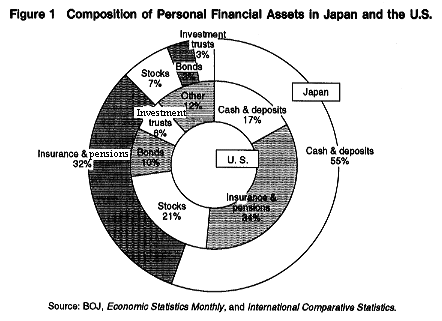
The Big Bang will expand opportunities to participate in financial markets not only for companies but for individuals based on the principle of self-responsibility. As seen by the increase in foreign currency deposits and foreign bond investments, individual investors are already assuming currency risks as they become increasingly familiar with the risk-return tradeoff.
The securitization of real estate should be pursued in response to this demand for new financial products. In this paper, we look at the current status of real estate securitization, propose measures for the full-fledged development of securitized products, and consider the issues involved in their realization.
2. Characteristics of Securitized Products to Date
The first small-denomination real estate financial product was sold domestically in 1987 in the form of real estate investment trusts, wherein a joint ownership interest of real estate is sold to multiple investors. Many realty companies followed suite with similar products, all claiming to produce tax benefits (through income tax savings based on cost deductions and depreciation, and through inheritance tax appraisal) based on the premise that property values would continue to rise. However, these products were low in liquidity due to transaction restrictions on individuals.
Later, partnership-type securitized products appeared from developers who qualified as special real estate joint ventures under a business law enacted in 1995. However, these too were practically illiquid.
Separate from these small-denomination products advanced by the real estate industry, securitization methods have been adopted recently for the disposal of nonperforming loans of financial institutions. These products involve complicated arrangements developed for a limited number of institutional investors, and have practically no liquidity. In addition, their real estate collateral, which ultimately needs to be sold, carries a downside price risk which is generally borne by financial institutions who originated the structure (Table 1).
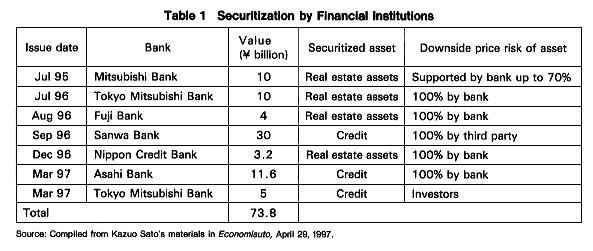
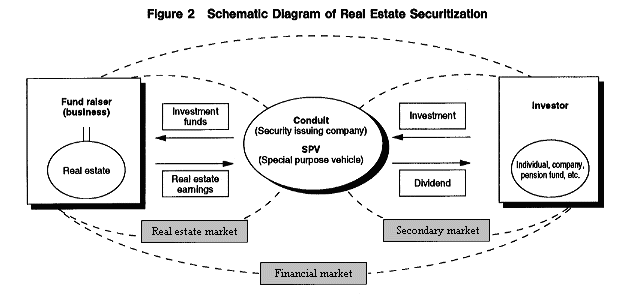
In theory, securitized real estate products, like other financial products, should be liquid and negotiable so that investors including individuals can freely buy and sell them. However, the products that have appeared thus far−syndicated real estate investment products and securitized products from real estate collateral of nonperforming loans−are available only to a limited group of investors and practically illiquid (Table 2).
The comprehensive policy for liquidity of real estate collateral announced in March1997 deals with impediments to securitization in the tax system and laws and regulations by calling for reforms limited to the nonperforming loans and real estate collateral held by financial institutions. While this is meant to help financial institutions dispose of their nonperforming loans, what it actually does is put the real estate collateral off of balance sheets for a certain period, and postpone the reporting of losses. In the future, unless the real estate market improves and buyers appear for this real estate, banks will have to buy it back.
While the policy represents a step forward, its limited scope of nonperforming loans and real estate collateral makes it a far cry from genuine securitization. Despite the arrangements for selling securitized products, the restriction on purchasers does not facilitate the growth of a secondary market.
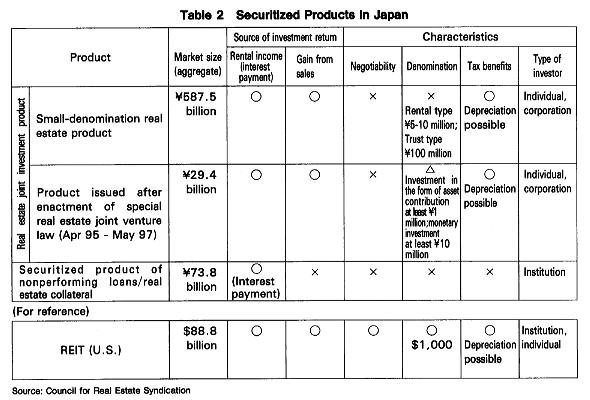
As with the Big Bang, the purpose of real estate securitization is not to protect the real estate industry or rescue financial institutions, but to provide attractive investment products and markets to domestic and foreign investors. Toward this end, genuine securitized products are needed that anyone can freely buy and sell.
3. Desired Characteristics of Securitized Products
- offer the advantages of real estate investment at relatively low investment denominations
- assure liquidity
- have rational methods for risk evaluation
Traditionally, the merits of real estate investment have consisted of tax benefits from depreciation and capital gains from rising land prices. However, the collapse of the asset bubble has practically eliminated hopes of capital gains.
Still, capital gains are essentially generated not from speculation or unearned income from owning unproductive land, but from land rent, which represents the use value of appropriately managed and utilized land. Both the income generated from such property, as well as the value (price) of the real estate itself will rise in the long term as the economy grows, and act as a hedge against inflation where fixed income bonds and savings deposits cannot. Thus good quality real estate still offers attractive investment opportunities.
After the asset bubble collapsed and brought about the first postwar plunge in land prices, the real estate market acquired a cynical mood and investment behavior that seeks capital gains from rising land prices seems to have disappeared. Nevertheless, it should not reject, even by international standards, behavior in which the real asset value is maintained or capital gains are obtained through the effective use of land.
Compared to other financial products, real estate has been a high-risk investment due to the large investment denominations required, uniqueness of each property, and low liquidity. The purpose of genuine securitization of real estate is thus to offer investment opportunities in real estate that ordinary investors can access in relatively small denominations.
The second characteristic of assuring liquidity is the completely reasonable condition that investors be able to easily transact financial products as necessary.
The third characteristic of providing rational evaluation of investment risk refers to clarifying the relationship between risks and returns, providing information to enable comparison with other financial assets, and having ratings institutions and investment advisors who can evaluate products for investors.
Securitized products with such characteristics already exist in the U.S.: REIT (real estate investment trusts) and MBS (mortgage backed securities). A REIT collects investments from many small investors−the minimum investment is approximately 100,000 yen−and is an attractive product among individual investors. An MBS is a bond backed by residential mortgages or properties.
The securitization market in the U.S. was not large from the beginning. REITs, which have had two market crises in the past, today enjoy a robust market among individual investors, particularly baby boomers who are managing their assets in preparation for retirement.1
The success of securitized products in the U.S. has come about after having undergone a variety of experiences and becoming refined into attractive products for investors. In addition, these products are monitored similar to stocks and bonds by the Securities and Exchange Commission (SEC), which protects investors by rigorously overseeing issuers and requiring them to publicize information such as the terms of rental contracts and revenue projections.
1 REITs became popular against the backdrop of a real estate boom that appeared in the 1960s. However, they faltered between 1973 and 1983 as many went bankrupt. They recovered, but met a second crisis in the late 1980s due to the stock market decline and real estate slump. However, they recovered as the real estate market recovered in the 1990s, and reach a market value of $88.7 billion in 1996. Half of the investors are individuals.
The MBS market in the U.S. became full-fledged in the 1970s with the public subscriptions of federally guaranteed products (GNMA, FHLMC, etc.). In the 1980s, products appeared that reduced the prepayment risk peculiar to MBS, and products with different combinations of principal and interest. The late 1980s saw the appearance of commercial mortgage backed securities (CMBS), which involved commercial properties. The CMBS became more advanced due to the RTC's disposal of the failed assets of S&Ls, becoming the main form of securitized product.
4. Issues in Achieving Genuine Securitization
For example, rental contracts for commercial properties in the U.S. are relatively long term (10 years), and in case of cancellation require rent payment for the remaining duration. These terms assure a long-term cash flow. In contrast, contracts in Japan are renewed every two years, and can be canceled without penalty with six months notice. The inconstancy of rental income makes it difficult not only to predict future earnings but to make appraisals based on earnings repayment.
In the U.S., the disclosure of real estate transaction prices and other market information enables more rational and reliable real estate evaluations. On the other hand, land prices in Japan are ambiguous, and advertised rent levels can differ greatly from contract levels. In addition, past balance sheet data for properties are not maintained.
There are also problems with real estate appraisal methods. Whereas foreign countries appraise the land and structure together based on use value, Japan needs to reevaluate its method of appraising land and structure separately. In the future, even if it is possible to assign a price and securitize land that is not expected to generate a return, there are not likely to be many buyers. The first step in securitization will be to distance itself from a focus on speculative gains rather than the use value of land.
Financing methods also differ greatly. In the U.S., most mortgages are done in the form of nonrecourse finance on the property, the default risk can be accurately ascertained by properly evaluating the balance sheet data and price of the mortgaged property.2
It is also necessary to review real estate taxation. In particular, gains from the sale of real estate are treated in the west as ordinary corporate income and taxed at the corporate tax rate. In Japan, however, an extra 5 percent for long term gains (over five years), 10 percent for short term gains (two to five years), and 15 percent for very short term gains (zero to two years) is added to the corporate tax rate, reducing the after-tax return. Also, frequent tax revisions based on changing economic conditions make risks and returns more difficult to ascertain. Transaction taxes (in Japan, the real estate acquisition tax and registration and permit tax) are also higher than in the west. Thus a major issue is the reduction of tax costs associated with real estate transactions.
Unless the market practices and systems mentioned above are not changed, the real estate securitization market will not expand even if REITs become legalized. For genuine securitization, ordinary real estate investment markets must be reformed to establish the basic conditions of a financial market.
2 This is a type of real estate investment finance which limits the debt liability to the collateral real estate if the lessee fails to pay. By relinquishing ownership of the collateralized property, the lessee's debt liability is fulfilled.
5. Conclusion: Economic Maturity and the Aging of Society
Japan's obsession with land prices culminated in the bubble era, when people boasted that the value of Japan's land was worth four times that of the entire U.S. But this obsession with land prices diverted investment from structures, and as a result hindered the formation of quality urban building stock that could be passed on to future generations.
Fifty years in the postwar era, Japan now needs to renew and reorganize its urban stock of office buildings, housing, transportation network. But the aging population and decline, low economic growth, there is concern that the ability to invest in real estate stock is declining. Real estate securitization not only offers market participants benefits associated with real estate investment, but holds promise as a new form of financing and asset implementation for the formation of high quality urban stock (Table 3). Investors can work on their own asset formation while providing funds to reorganize the urban stock.
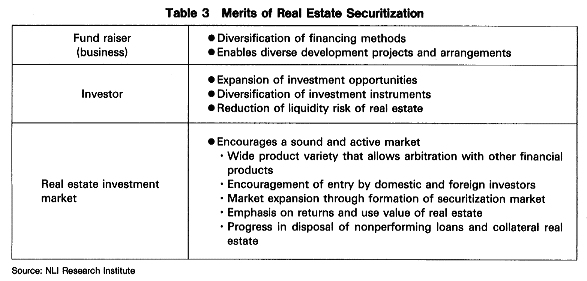
Based on this recognition, a number of research centers and groups have begun preparing data on rental fees as an investment indicator. There are also signs that market practices are changing, such as the diversification of rental contracts and reevaluation of laws that hinder free contracts by excessively protecting lessees.
The pace of change can be accelerated by the emergence of attractive real estate securitized products. For example, securitization of a famous high rise building or a large-scale development project located in the center of a city. Considering the possibility that the revised foreign exchange law could cause funds to shift to REITs in the U.S., work needs to be started immediately on securitization by fund raisers, investors, government agencies, and other market participants.
Masanori Oka
Research field
レポート紹介
-
研究領域
-
経済
-
金融・為替
-
資産運用・資産形成
-
年金
-
社会保障制度
-
保険
-
不動産
-
経営・ビジネス
-
暮らし
-
ジェロントロジー(高齢社会総合研究)
-
医療・介護・健康・ヘルスケア
-
政策提言
-
-
注目テーマ・キーワード
-
統計・指標・重要イベント
-
媒体
- アクセスランキング

















